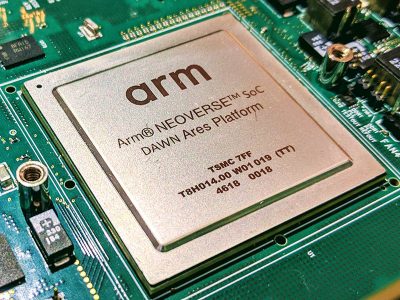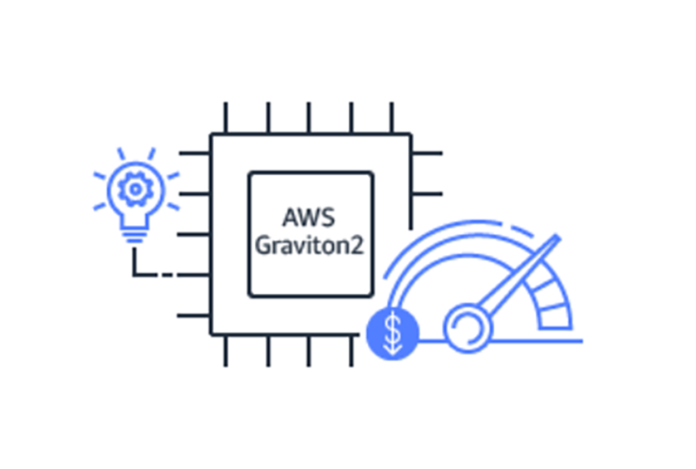AWS for all practical purposes declared war on Intel as it announced its new Graviton2 CPU. Some of the reports recently on the new chip, that the entire industry knew was coming, were strange focusing on incremental improvement positioning the chip against 2021’s Intel Xeon Ice Lake-D generation. Instead, AWS has signaled to Intel that its chips are not good enough. This is a big deal because Intel has been creating custom SKUs for AWS and has been subsidizing sales to AWS through its enterprise and SMB segments. Now, after that investment, AWS is poised to betray Intel.
AWS Graviton2
The AWS Graviton2 has new Arm Neoverse N1 64-bit cores. You can read more about the cores in A Journey to Next-Gen Arm Neoverse N1 and E1 Cores. These are next-generation cores versus what we saw with the original Graviton that is in production today.
Other key specs of Graviton2 include 8x DDR4-3200 lanes, larger caches, 25Gbps networking (for the instances), and increased memory capacity support with instances already announced up to 512GB in capacity.

Amazon is touting large per-vCPU performance gains. From the AWS announcement:
- SPECjvm 2008: +43% (estimated)
- SPEC CPU 2017 integer: +44% (estimated)
- SPEC CPU 2017 floating point: +24% (estimated)
- HTTPS load balancing with Nginx: +24%
- Memcached: +43% performance, at lower latency
- X.264 video encoding: +26%
- EDA simulation with Cadence Xcellium: +54%
(Source: AWS)
Why Context Matters
What AWS Graviton2 represents is something entirely different than with the original Graviton. While the original Graviton had acceptable performance when we put the AWS Graviton and its Arm CPU performance in context we found it to be more in-line with Intel’s embedded parts. Years ago we also tested an Annapurna Labs ARM storage server and found the performance more competitive with Atom SKUs.
With the AWS Graviton2, the company is targeting not just the lower-end of the stack, but instead the heart of Intel Xeon CPUs. In the 2nd Gen Intel Xeon Scalable series, 12-20 Xeon cores are considered mainstream and Graviton has more Arm cores with greatly increased IPC. By selling its own CPUs, AWS is able to also define a vCPU to equal or better Intel performance. That is the big deal that AWS saw early in its existence.
In its early days, AWS had Intel Xeon and AMD Opteron infrastructure but has always denominated in vCPUs to allow for a broader supplier base. Now, AWS has not only adopted AMD EPYC 7002 Series “Rome” CPUs, but it is also providing its own CPUs. Both the EPYC parts and its own Graviton2 parts have 64 cores and DDR4-3200, well beyond what Intel is offering with its 2019 lineup. Using vCPU denomination, AWS can effectively set how much value a customer gets in an instance.
I have always maintained, if I am at Intel, AMD taking market share is the best case. Intel has gone through that cycle before exiting the Opteron era with a near-monopoly in the market. AWS ran on Intel Xeon for years when AMD and Arm were not in contention.
In contrast, the Arm-based Graviton2 is the worst-case scenario. Steep discounts in the hyper-scale market when there was little competition fueled AWS growth. In contrast, those buying enterprise servers tend to be higher-margin customers. With Graviton2, AWS is signaling that it is going to make Arm a first-class competitor to Intel in its infrastructure. In 2016 we said that the Cavium ThunderX was important for Arm developers to kickstart a lagging ecosystem. With the Cavium/ Marvell ThunderX2 review, we showed how the Arm ecosystem was greatly changed by 2018. As Graviton2 comes out, more developers will port to Arm and/ or program architecturally agnostically since the platform is going to be more of a Xeon competitor than a Xeon D competitor providing higher scaling.
As the software ecosystem continues to support Arm, AWS controls the ultimate value lever in its vCPU pricing and capabilities. We are also likely to see other cloud vendors jump on the next-gen Arm bandwagon. The savior for x86 may well be AMD EPYC, as strange as that sounds. AMD EPYC 7002 had 64 cores (and 128 threads) per socket, much larger caches than Graviton2, 8 channel DDR4-3200 support, and PCIe Gen4 support in 2019 while Graviton2 will get there in 2020 a year later. In 2020, we should see the EPYC 7003 series which will up the ante further on the x86 side, but AWS will control how it values AMD, Intel, and Arm cores with its vCPU abstraction.
Final Words
For Intel’s part, it is racing to get beyond the 10nm generation that was needed in 2019, but we will not see until the second half of 2020. Intel is a big company with a strong balance sheet that can weather essentially missing a product cycle with the 10nm delays. Still, what is clear is that from 2017 to 2020 that big process miss, combined with a strategy of pandering to cloud customers over the enterprise when it had an effective monopoly, is going to mean continued share loss into 2020.
By positioning a product as a Xeon competitor, the AWS Graviton2 will shift the balance of power significantly and in a way that the original Graviton could not. AWS has effectively betrayed the Intel partnership in the Xeon monopoly era. Now that this is public, the next question is what other cloud providers will follow suit either publicizing their internal projects or partnering with one of the Arm server vendors for next-gen products. Competition is good for the industry and we are far from the “boring” days in the 2014-2017 era.





This is the point. Intel gouged the Enterprise so it’d be able to sell more to cloud guys. Now AWS is sending a giant FU to Intel.
You’re dead on with the arm development implications.
>This is a big deal because Intel has been creating custom SKUs for AWS and has been subsidizing sales to AWS through its enterprise and SMB segments.
Do we know this as a fact? I mean having custom Binned CPU is hardly any substantial investment. And I am wondering if subsidizing is correct because this implies Intel is losing money on Sales to AWS, which I dont think is correct. they may be earning less on HyperScaler.
That is different to say UPS and Fedex Subsidizing Amazon, because each delivery has a Unit cost and the margin are thin.
Correct me if I am wrong.
I am more worried about AMD at the moment, we finally understand why TSMC is having 7nm capacity issues.
AWS is worse than Microsoft of the 90s.
I don’t think it’s necessarily a good thing for the software ecosystem as a whole that cloud providers move to their own proprietary CPUs, this just leads to even more vendor lock-in, which most providers love but customers don’t like in particular.
A lot of the cloud server workloads really only need an ALU to do basic program flow control and IO, SIMD units and such are pretty much wasted in such use cases, but they also take up a significant amount of die space, and waste energy even if not used.
This fairly low computational throughput, high core and thread count CPU seems to be far better suited for those low computational demand instances. You don’t need a semi truck to commute, as simple as that.
What’s perhaps most interesting here is that with AWS it’s the customers who pick the winner, not AWS.
So AWS confidence that customers will pick ARM instances over Intel or AMD is the real news, each one of which would be the “betrayor”, not AWS who is mostly expanding the choices customers have.